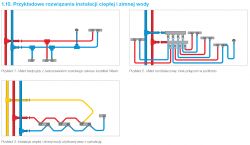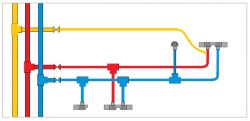Hi,
I am preparing to install cold and hot water with circulation in PEX system. I found these diagrams in Wavin materials:

I was initially planning to do the circulation as follows:

However, example 3 from the first diagram solves the problem of lack of circulation on the section "tee - faucet connection", so hot water should fly without delay. The problem that arises is the size of the through fixed tees that are available to implement the installation according to example 3. Wavin produces them in sizes 16x1/2x16 and 20x1/2x20, while Kisan only 16x1/2x16. As for the regular elbows established, both one and the other manufacturer offer them in sizes 16x1/2, 20x1/2 and 20x3/4.
The diameter of the "riser" for cold and hot water is 25mm. The first in line will be the shower (according to the Wavin pipe diameter selection calculator, the recommended diameter is 25mm), followed by 2 sinks (16mm) and the kitchen sink (16mm). Due to the lack of through tees and elbows established in the size of 25mm for the shower, I want to make a connection tee 25x16x20 + elbow 20x3/4. To the tee connect a through tee Kisan 16x1/2x16 (the first sink), to it another the same (the second sink) and another (the sink). I'm wondering whether, with such an installation, there will be a problem with water pressure in case of simultaneous use of, for example, a shower, sink and basin? Should I use the larger Wavin 20x1/2x20 through tees, or stay with the originally planned solution?
Greetings,
Kamil.
I am preparing to install cold and hot water with circulation in PEX system. I found these diagrams in Wavin materials:

I was initially planning to do the circulation as follows:

However, example 3 from the first diagram solves the problem of lack of circulation on the section "tee - faucet connection", so hot water should fly without delay. The problem that arises is the size of the through fixed tees that are available to implement the installation according to example 3. Wavin produces them in sizes 16x1/2x16 and 20x1/2x20, while Kisan only 16x1/2x16. As for the regular elbows established, both one and the other manufacturer offer them in sizes 16x1/2, 20x1/2 and 20x3/4.
The diameter of the "riser" for cold and hot water is 25mm. The first in line will be the shower (according to the Wavin pipe diameter selection calculator, the recommended diameter is 25mm), followed by 2 sinks (16mm) and the kitchen sink (16mm). Due to the lack of through tees and elbows established in the size of 25mm for the shower, I want to make a connection tee 25x16x20 + elbow 20x3/4. To the tee connect a through tee Kisan 16x1/2x16 (the first sink), to it another the same (the second sink) and another (the sink). I'm wondering whether, with such an installation, there will be a problem with water pressure in case of simultaneous use of, for example, a shower, sink and basin? Should I use the larger Wavin 20x1/2x20 through tees, or stay with the originally planned solution?
Greetings,
Kamil.


